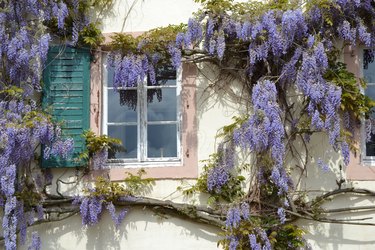
If you've ever seen a wisteria vine (Wisteria spp.) in bloom, you'll likely remember its lavender-to-violet, 1-foot-long flower clusters that hang down like bunches of grapes from the vines. That high visual impact makes it one of the most popular of climbing shrubs for home gardeners. Wisteria leaves turning yellow could signal a problem that needs attention, although it might also be a natural occurrence.
Wisteria Leaves Turning Yellow Normally
Video of the Day
Two types of wisteria are commonly grown: the Japanese wisteria (Wisteria floribunda) and the Chinese wisteria (Wisteria sinensis), which grow in U.S. Department of Agriculture plant hardiness zones 4 through 9 and 5 through 8, respectively. Both are deciduous, woody vines, and when new young leaves appear in spring, they're normally yellow in color when small and can remain slightly yellow for several weeks, eventually turning deep green as the season progresses.
Video of the Day
Similarly, when cool weather arrives in fall, leaves gradually turn yellow and individual leaflets begin to drop from the plant, a normal occurrence that precedes winter. So if you see new leaves that are yellow early in spring or older leaves turning yellow in fall, this is likely normal and only reflects seasonal changes in the plant's activity.
Fungal Disorders Affecting Wisteria
Wisteria vines are usually tough, easy-to-grow plants that need little special attention. But a plant might develop a fungal disorder, especially if grown in overly wet conditions. For example, powdery mildew could cause yellowish mottling on wisteria leaves, especially in summer when the weather warms. Other fungal disorders called cankers can also cause leaves to yellow and wilt, sometimes accompanied by soft, dark spots on branches that might eventually die back.

Prune away any affected branches, but wipe your pruning blade in rubbing alcohol between cuts to avoid spreading the disease. These fungal problems are best prevented by watering the plant with a soaker hose or drip irrigation to keep foliage dry, and by regularly clearing away plant debris from under the plant.
Insect Pests Affecting Wisteria
Wisteria leaves turning yellow can also be the result of insect pests. These include tiny, soft-bodied, yellowish-white pests called aphids that leave behind a sticky substance on leaves, called honeydew. They're best treated by spraying the plant until it's dripping wet with insecticidal soap, diluted in water at a rate of 6 tablespoons per gallon, and repeating this every two weeks as needed. Hard-bodied scale insects, which resemble raised, dark spots on stems and leaves, can also damage foliage and eventually cause leaves to yellow and fall. To eradicate scale, spray the wisteria vine with a light horticultural oil, diluted at a rate of about 5 tablespoons per gallon of water, but check your product label for further instructions.
Viruses Affecting Wisteria

A wisteria vine might also develop yellow leaves if it is infected with a plant virus, such as the tobacco mosaic virus. This infection causes leaves to develop yellow spots or streaks, while the leaf looks otherwise healthy, although you might see some slowing of leaf growth or a distortion of leaf shape. There's no cure for a viral infection, but it doesn't usually do significant damage, especially if the plant's cultural needs are met and it's otherwise healthy. If you suspect a wisteria has contracted a virus, minimize stress to the plant by giving it even moisture, watering during dry spells to provide about 1 inch of water weekly, including any rain.
- Missouri Botanical Garden: Wisteria Sinensis
- Fine Gardening: Wisteria Floribunda
- University of California Agriculture and Natural Resources: Wisteria -- Wisteria Spp.
- Royal Horticultural Society: Wisteria Problems -- Frequently Asked Questions
- University of California Agriculture and Natural Resources: Viruses